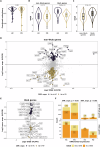Human gut microbiome gene co-expression network reveals a loss in taxonomic and functional diversity in Parkinson's disease
- PMID: 40707492
- PMCID: PMC12289924
- DOI: 10.1038/s41522-025-00780-0
Human gut microbiome gene co-expression network reveals a loss in taxonomic and functional diversity in Parkinson's disease
Abstract
Gut microbiome alterations are linked to various diseases, including neurodegeneration, but their ecological and functional impacts remain unclear. Using integrated multi-omics (metagenomics and metatranscriptomics), we analyse microbiome gene co-expression networks in Parkinson's disease (PD) and healthy controls (HC). We observe a significant depletion of hub genes in PD, including genes involved in secondary bile acid biosynthesis, bacterial microcompartments (BMCs), polysaccharides transport and flagellar assembly (FA). Blautia, Roseburia, Faecalibacterium and Anaerobutyricum genera are the main contributors to these functions, showing significantly lower expression in PD. Additionally, we identify a strong correlation between BMC and FA expression, and an apparent dysregulation in cross-feeding between commensals in PD. Finally, PD also exhibits reduced gene expression diversity compared to HC, whereby higher gene expression correlates with greater diversity. We identify disruptions in gut metabolic functions, at both taxonomic and functional level, and microbiome-wide ecological features, highlighting targets for future gut microbiome restoration efforts.
© 2025. The Author(s).
Conflict of interest statement
Competing interests: The authors declare no competing interests.
Figures






References
-
- Elbaz, A., Carcaillon, L., Kab, S. & Moisan, F. Epidemiology of Parkinson’s disease. Rev. Neurol.172, 14–26 (2016). - PubMed
-
- Howell, M. J. & Schenck, C. H. Rapid eye movement sleep behavior disorder and neurodegenerative disease. JAMA Neurol.72, 707–712 (2015). - PubMed
-
- Fasano, A., Visanji, N. P., Liu, L. W. C., Lang, A. E. & Pfeiffer, R. F. Gastrointestinal dysfunction in Parkinson’s disease. Lancet Neurol.14, 625–639 (2015). - PubMed
-
- Braak, H., Rüb, U., Gai, W. P. & Del Tredici, K. Idiopathic Parkinson’s disease: possible routes by which vulnerable neuronal types may be subject to neuroinvasion by an unknown pathogen. J. Neural Transm.110, 517–536 (2003). - PubMed
-
- Cryan, J. F., O’Riordan, K. J., Sandhu, K., Peterson, V. & Dinan, T. G. The gut microbiome in neurological disorders. Lancet Neurol.19, 179–194 (2020). - PubMed
MeSH terms
Grants and funding
LinkOut - more resources
Full Text Sources
Medical

